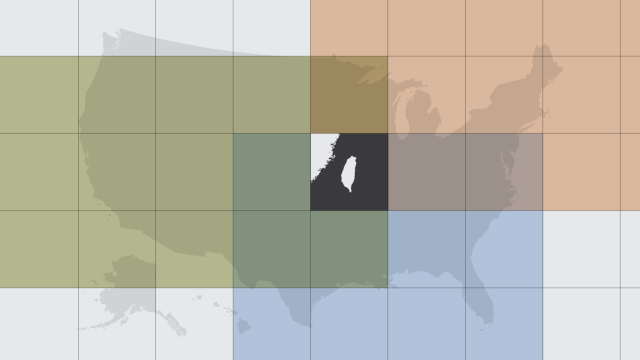
The question of how many Taiwanese people live in the United States may seem straightforward to answer, but surveys can produce widely different estimates depending on how people are asked about their backgrounds. Using different measures of Taiwanese identity from the U.S. Census Bureau, Pew Research Center has produced estimates of the U.S. Taiwanese population ranging from 195,000 to 697,000 in 2019. In this post, we’ll explain how we arrived at this range of estimates and detail some of the challenges inherent in the task.
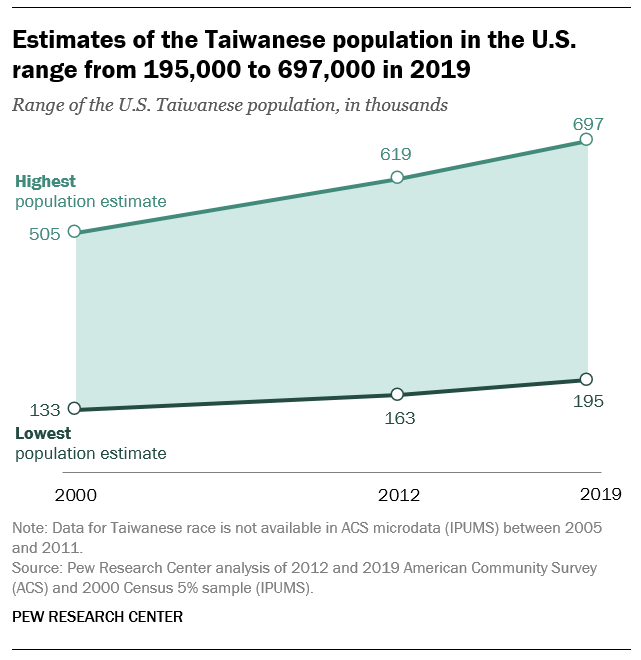
Measuring Taiwanese identity — and identity more broadly — is difficult because the terms used in survey questions can mean different things to different people. Typically, identity is measured in surveys with questions about race, ancestry, birthplace or language. Answers to these questions can be heavily influenced not only by respondents’ interpretations, but also by question wording and placement, as well as the way response options are presented. Moreover, an identity term can be a marker for any number of concepts, such as geography, culture or race. And for some, a single identity term may represent multiple, overlapping identities.
Decisions made by the producers of this kind of data can also limit researchers’ ability to investigate the nuances of more specific categories of identity. When some responses are grouped with others or suppressed altogether, researchers may be constrained in their efforts to dig deeper.
Measuring the U.S. Taiwanese population with Census Bureau data
The American Community Survey (ACS) and other U.S. Census Bureau surveys include several questions for measuring racial and ethnic identity. We’ll focus on three questions here — about race, ancestry and birthplace:
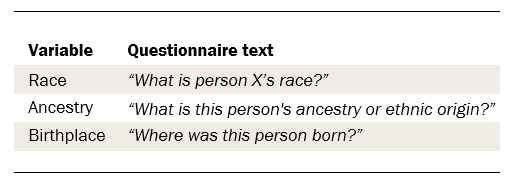
Each of these questions provides a different, but probably incomplete, way to estimate the size of the Taiwanese population in the U.S. (Other measures related to identity are also available in Census Bureau data, including Hispanic origin, language spoken in the home, citizenship and the identity of parents and other relatives in the household.)
The Census Bureau’s race question might seem to provide the best estimate of the Taiwanese population in the U.S., but it has some particular shortcomings. The question offers specific choice options among the six largest Asian groups (Asian Indian, Japanese, Chinese, Korean, Filipino and Vietnamese) and gives examples of the five next largest Asian groups (Hmong, Laotian, Thai, Pakistani and Cambodian) to write in.

Taiwanese is not given as a specific choice or an example as the Taiwanese population measured by the race question is smaller than these 11 Asian groups; in 2019, Taiwanese ranked 12th among Asian origin groups. Respondents must choose to write in a response of Taiwanese, as opposed to selecting one of the pre-specified race options. Moreover, the actual Taiwanese population may be substantially larger than those who identify as Taiwanese in response to this question. Some who identify their ancestry as Taiwanese in the ancestry question do not opt to write in Taiwanese as their race. And in other cases, some respondents who identify their birthplace as Taiwan do not identify as Taiwanese by either race or ancestry.
Measuring the Taiwanese population in the U.S. with single identifiers
The Census Bureau’s detailed race variable is the primary measure used to estimate the size of all Asian-origin populations in the U.S. According to the 2019 ACS, there were 195,000 Taiwanese people in the U.S., as measured by the question on race. This is by far the smallest estimate based on the various concepts used to measure identity.
The ancestry question is another way to estimate the U.S. Taiwanese population. In 2019, 375,000 people opted to write in “Taiwanese” as a response to this question.
The birthplace question produced the largest estimate of Taiwanese in the U.S. based on a single measure, with 409,000 reporting in 2019 that they were born in Taiwan. This measure, however, does not include U.S.-born people with a Taiwanese background.

Measuring the Taiwanese population in the U.S. with multiple identifiers
Instead of using one of the three single identifiers to measure the size of the Taiwanese population in the U.S., researchers can combine these, together with other indicators, to provide additional information and broader estimates.
Using the single identifiers, for example, the lowest estimate of the Taiwanese population in the U.S. in 2019 is 195,000 — the number who said their race is Taiwanese alone. If those who claimed to have Taiwanese ancestry (but not Taiwanese race) are added, the population total increases by 213,000. The additional inclusion of those who were born in Taiwan but did not claim either Taiwanese race or ancestry raises the figure by another 173,000, for a total of 580,000 people who were Taiwanese by race, ancestry or birthplace in 2019.
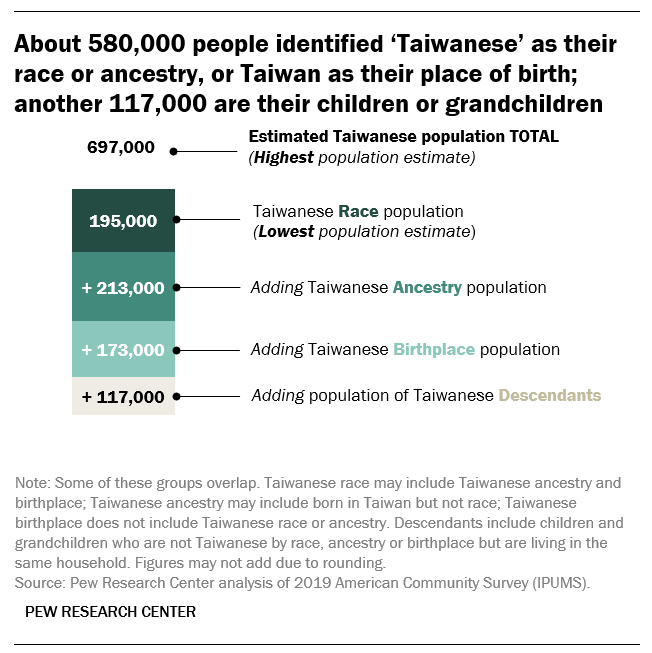
Using available microdata, we can also identify additional descendants of respondents who answer “Taiwan” or “Taiwanese” under the race, ancestry or birthplace question. Specifically, for these estimates we define descendants as individuals who are not identified as Taiwanese by any of the three measures but are children or grandchildren of individuals in the household who do identify as Taiwanese. Altogether, there were an additional 117,000 individuals who could be identified as descendants with Taiwanese relatives in 2019. Almost all of these descendants are U.S. born who are identified as Chinese by race or ancestry, often in combination with other identities. Adding these individuals brings the final total to 697,000 Taiwanese in the U.S. in 2019, the highest estimate in our range.
How much do the different measures overlap?
As noted above, a total of 580,000 people claimed at least one of the three Taiwanese identity measures — race, ancestry or birthplace — in 2019. About half of these — 290,000 people — claimed Taiwanese on only one measure. At the same time, only 109,000 individuals claimed all three measures, identifying their race as Taiwanese, their ancestry as Taiwanese and their birthplace as Taiwan.
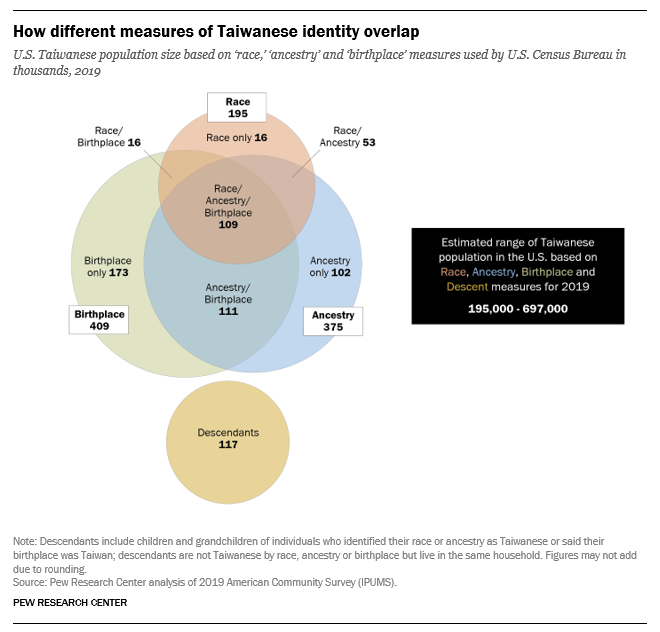
The 195,000 who identified their race as Taiwanese is relatively small, but 92% in this group overlap with at least one of the other measures. Only 8% (or 16,000) identified their race as Taiwanese but did not say they have Taiwanese ancestry or that they were born in Taiwan.
Of the 375,000 people who reported Taiwanese ancestry, by contrast, 102,000 (or 27%) did not identify their race as Taiwanese and did not say they were born in Taiwan. Finally, 42% of the 409,000 people who said they were born in Taiwan, or 173,000, did not identify as having either Taiwanese race or ancestry.
Conclusion
The different estimates of the U.S. Taiwanese population produced by these three measures may in part be due to different interpretations of the concepts of identity on the part of respondents. It’s also important to note that the multilayered nature of racial and ethnic identity is not exclusive to the Taiwanese population: It frequently surfaces when studying other identity groups, especially for groups with roots in countries and cultures outside the U.S. These complications can arise among those who identify as part of other Asian populations, those who identify as Hispanic or with Middle Eastern or North African groups, as well as those in the LGBTQ community. Adding other variables to the mix may introduce additional complications but may also sharpen the analysis.
Identity is a complex and multifaceted subject. Limitations imposed by survey research may lead to incongruity between how respondents see themselves and how they have been categorized in the data. The complex nature of Taiwanese identity draws attention to the need for more data to better understand not only the nuances of Taiwanese identity, but also identity among other groups in the U.S.
For more information on our analysis of Asians in the U.S., see our methodology page.




